Mark Sisson's Blog, page 219
June 13, 2016
Dear Mark: Bikram Yoga; Stored Toxins Impairing Fat Loss
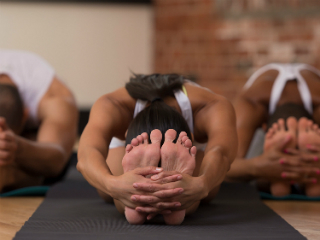 For today’s edition of Dear Mark, I’m answer two questions from readers. First, does Bikram yoga qualify as sprinting or high intensity training? It’s certainly intense, and it’ll make you sweat bullets and work hard to the point of nausea, but does it actually accomplish the same training effects as sprinting or intervals? Find out down below. Next, you often hear that body fat is the main repository for environmental toxins. This is true, but does that mean the body “holds on” to body fat to prevent systemic dispersal of the toxins it contains? Can stored toxins make losing body fat harder that it already is?
For today’s edition of Dear Mark, I’m answer two questions from readers. First, does Bikram yoga qualify as sprinting or high intensity training? It’s certainly intense, and it’ll make you sweat bullets and work hard to the point of nausea, but does it actually accomplish the same training effects as sprinting or intervals? Find out down below. Next, you often hear that body fat is the main repository for environmental toxins. This is true, but does that mean the body “holds on” to body fat to prevent systemic dispersal of the toxins it contains? Can stored toxins make losing body fat harder that it already is?
Let’s go:
I love doing Bikram yoga and wonder if you would consider it a sprint day or a high intensity day, or both?
Thanks,
Rebecca
Neither, actually. What do sprinting and other types of high-intensity training do to the body?
They preferentially burn body fat. Bikram yoga has been shown to induce modest reductions in the body weight of obese subjects, but that’s about it. There’s no indication that Bikram has significant or unique effects on actual body fat.
They improve your ability to burn body fat throughout the rest of the day—the after burner effect.
They improve bone mineral density. Bikram may help younger women retain bone density (PDF), but isn’t enough to stave off the loss of bone density in older women (PDF). For that, you need impact and high stress—sprints and weights.
They increase mitochondrial biogenesis. This is the literal construction of new mitochondria, the power plants of the cell. There’s no evidence that Bikram yoga can induce mitochondrial biogenesis. You need intensity for that.
They take just a few minutes. This isn’t by design; when you’re sprinting or working at truly high intensities, you cannot do more than a few minutes of work. The effort required precludes high volume. Meanwhile, the average Bikram yoga session lasts about 90 minutes. There’s no way you can sprint for 90 minutes, or maintain high intensities for an hour and a half. It just isn’t possible.
They consist of moving really, really fast for short bursts. Bikram is movement but slow and gradual with lots of holds. If it can be classified as anything, it’d be isometric strength and flexibility training. Great stuff. Just not sprinting.
Of course, this isn’t to suggest that Bikram is pointless. It’s not. It’s great. There’s considerable evidence in favor of doing it, especially if you enjoy it.
One study found that 24 sessions of Bikram yoga in eight weeks increased deadlift strength, shoulder flexibility, and hamstring flexibility while modestly lowering body fat in healthy adults. The no-yoga control group had no such improvements.
Bikram yoga has also proven useful in the development of balance. Specifically, three sessions per week (identical to your schedule once again) seemed to help the most unsteady subjects improve their balance. Those subjects who were already pretty stable in unstable situations didn’t see as much of a benefit. Balance is crucial, not just for athletes but for older people who don’t want to fall and break any bones.
In another study, Bikram yoga reduced the time it took subjects to fall back asleep after awakening in the night. Subjects were quicker to fall back asleep on yoga days than on non-yoga days. Better sleep is incredibly important.
Bikram yoga is awesome stuff, but I don’t think it qualifies as sprinting or high intensity. That’s okay, though. It just means you can do Bikram and sprint (or do some alternatives) and get the benefits of both.
Dear Mark,
Thank you so much for the wealth of information and sage advice you provide on Mark’s Daily Apple! I love hearing your voice of reason on so many topics. I wasn’t able to find anything specific to this question on your website.
There is a lot of talk out there about “diets failing” because toxins remain trapped inside our bodies. Body fat is a form of protection, the body “enrobes” the toxins with fat to prevent organ damage. So until you find a way to eliminate them from your system, you won’t see long-term success with a dieting program. They also claim that when body fat is burned, the toxins become more concentrated in your body, causing the body to “rebound” and produce more fat to again store thhise toxins.
Now, many of those touting this viewpoint are selling “cleanse” products or products that “support the body’s natural functioning”. I am just wondering if there is any scientific research to support this claim that the body resists burning fat because it is being used to encapsulate toxins. I would love to hear your take on this.
Thank you so much!
Erin
They aren’t totally making things up. Adipose tissue does store toxins. A number of studies even indicate a relationship between recent weight loss and elevated serum levels of certain “toxins,” like persistent organic pollutants (which include certain pesticides, industrial chemicals, and pharmaceuticals).
In one, middle-aged people with a history of long-term weight loss had elevated levels of persistent organic pollutants. Those who hadn’t lost weight had lower levels. A more recent paper suggests this effect may be short-lived. Obese women who lost a ton of weight had elevated levels of POPs for the first 3 months, but at the 5-year followup, those who’d kept the weight off had lower levels of pollutants.
Visceral fat seems to store a greater proportion of pollutants. A recent study found that people who’d lost most of their weight in the belly had greater levels of pollutants than folks who’d lost mostly subcutaneous fat. Another measured pollutants in existing adipose tissue, finding that visceral fat contained more than subcutaneous. If the hypothesis is true, and body fat carrying the most pollutants is the most stubborn and hardest to lose, we’d expect that visceral fat is the hardest type to get rid of. But that isn’t the case at all. Studies show that visceral adipose tissue goes quicker than other types of body fat, even though it’s the highest in pollutants and other toxins.
Plus, it’s not like those toxins are totally innocuous sitting in body fat. They’re still in your body, and the evidence shows that higher levels of pollutants in adipose tissue correlate to more metabolic syndrome, especially poor blood sugar control and high blood pressure.
Everything equal, it’s better to lose body fat than hold on to it. Don’t let the fear of toxins keep you from losing excess body fat.
I haven’t seen any evidence that the body “knows” it’s storing toxins in fat and prevents weight loss to avoid their dispersal into circulation, though. If that’s the case, and the body is “smart,” it goes both ways: if you eat a weight loss diet replete in liver-supportive nutrients and maintain a healthy lifestyle, the body should “know” it can burn fat without overloading itself with toxins. I’m talking about:
N-acetyl-cysteine.
Choline.
Milk thistle.
Various phytonutrients from colorful fruits and veggies, spices like ginger and curcumin and garlic.
Plenty of exercise and sleep.
A month-long fast consisting of lemon, water, cayenne pepper, and activated maple syrup.
I’m kidding about one of those (it shouldn’t be hard to guess which).
But seriously: don’t worry about fat loss released toxins, or toxins inhibiting fat loss. I mean, what’s your other option? Accumulating even more body fat to act as reservoir for dangerous pollutants? It’s silly. Fat loss is consistently and almost unanimously linked to a bevy of health benefits. That research is conclusive. It’s vindicated. If you’re reading this and following a Primal Blueprint lifestyle, you’ve probably shed some body fat. Has it helped you or hurt you? Has it improved your quality of life or hampered it?
Exactly.
Thanks for reading, all. Take care. Be well.




June 12, 2016
Weekend Link Love – Edition 404

Huge announcement this week. I just launched my Primal Health Coach program and I’m really excited about what’s to come. There’s also a new blog dedicated to Primal Health Coaching topics. Check it out.
Research of the Week
When you’re trying to improve aerobic capacity and mitochondrial function, should you run farther or faster? Yes.
Genes can predict professional success, income, personality, and even likability, but not happiness.
How different dietary fats affect alcoholic liver disease.
Everyone’s getting fatter, but some are getting fatter more slowly.
New Primal Blueprint Podcasts

Episode 123: Taylor Collins: Host Elle Russ hangs out with Taylor Collins, co-founder of Epic Provisions. If you want to hear how a vegan became the creator of the first grass-fed beef protein bar, why soil restoration is almost everything, and what else Epic has in store for us, listen to today’s episode.
Each week, select Mark’s Daily Apple blog posts are prepared as Primal Blueprint Podcasts. Need to catch up on reading, but don’t have the time? Prefer to listen to articles while on the go? Check out the new blog post podcasts below, and subscribe to the Primal Blueprint Podcast here so you never miss an episode.
14 Ways to Help You Look Primal
Why the Kind of Body Fat You Carry Matters
17 Activities for Primal Family Bonding
Why You Still Probably Need More Rest (and 23 Ways to Get It)
Interesting Blog Posts
An update on the existence of Lamarckian evolution.
Is Alzheimer’s an infectious disease?
Which salad ingredients go best together? Solid list.
Media, Schmedia
The National Academies of Science, Engineering, and Medicine thinks we should hold off on releasing genetically engineered organisms into the wild.
Candy makers shape nutritional science.
Does weight loss lead to wrinkles?
Everything Else
Could turning the Galapagos Islands into a rat sausage fest save endangered species?
Fleeing spiders blanket a flooded town in silk.
Techno-optimism butts up against biology’s complexity.
Stuff just keeps getting older.
Before hobbits, there were smaller hobbits.
NBA teams are discovering the importance of sleep and hiring experts to help them get more of it.
What’s happening here? Fitnessing is happening.
Recipe Corner
Dry-brining isn’t just for poultry.
Pickled avocados.
Time Capsule
One year ago (June 15 – June 21)
The Greatest Piece of Exercise Equipment Ever Invented – My love affair with the Versaclimber.
The Definitive Guide to Napping –How to be an intermittent layabout.
Comment of the Week
It’s strange to think that when we lose body fat, that includes all the nooks and crannies you’ve described above. “My, Martha, what a slim epicardial, intramuscular, and intrahepatic figure you hold. How do you do it?”
– That Martha’s a real catch, ain’t she, Tina?




June 11, 2016
Chicken Parmesan
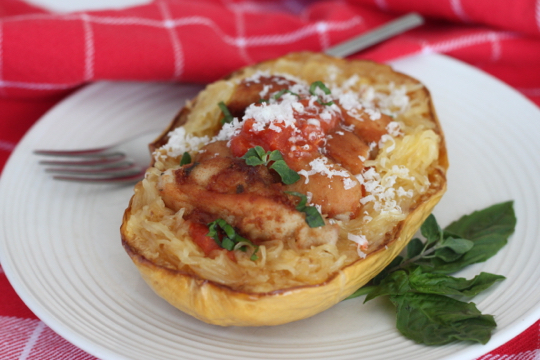 This Italian dish borrows an Asian trick for frying chicken: Use potato starch instead of flour and/or breadcrumbs for a crispy and gluten-free coating. Potato starch has been mentioned before as a potentially beneficial resistant starch. Unfortunately, heating potato starch can negate its RS function, which means you won’t benefit from eating it in this recipe. But it doesn’t change the fact that potato starch is gluten-free and, more importantly (if you love fried chicken), it’s a perfect crispy, crunchy coating.
This Italian dish borrows an Asian trick for frying chicken: Use potato starch instead of flour and/or breadcrumbs for a crispy and gluten-free coating. Potato starch has been mentioned before as a potentially beneficial resistant starch. Unfortunately, heating potato starch can negate its RS function, which means you won’t benefit from eating it in this recipe. But it doesn’t change the fact that potato starch is gluten-free and, more importantly (if you love fried chicken), it’s a perfect crispy, crunchy coating.
Plus, with a few other easy changes, you can turn Chicken Parmesan into a completely Primal meal: spaghetti squash instead of noodles, flavorful, juicy chicken thighs instead of breasts, and only a light sprinkle of aged cheese.
To coat chicken (or even fish) with potato starch, simply dredge it through the potato starch to evenly coat the meat. Then fry in at least an inch or two of lard or oil. The smaller the pieces, the faster they’ll cook. Frying the pieces twice makes for an even crispier coating.
In the case of these herb-coated chicken strips for Chicken Parmesan, once in the frying pan is enough. Toss the juicy, crispy chicken with the spaghetti squash noodles and marinara, and it’s a bowl of “pasta” that even an Italian grandmother would love.
Servings: 4
Time in the Kitchen: 1 hour
Ingredients:
2 spaghetti squash, cut in half, stringy insides and seeds scooped out
2 tablespoons extra virgin olive oil (15 ml)
4 to 6 boneless, skinless chicken thighs, cut into 1-inch/2.5 cm wide strips
1/2 cup potato starch (60 g)
3/4 teaspoon kosher salt (4 ml)
1 teaspoon dried oregano (5 ml)
1 tablespoon finely chopped fresh basil, plus more for garnish (15 ml)
2 cups marinara sauce, warm (350 g)
1/2 cup grated Parmigiano-Reggiano (optional) (45 g)
Lard, for frying
Instructions:
Recipe Note: Make sure to buy potato starch and not potato flour. They look similar but are very different. Potato flour will give you a soft, gummy coating, not a crispy coating.
Preheat oven to 375 °F/190 °C.
Brush each half of the spaghetti squash with olive oil on the flesh side. Season with salt and pepper. Bake spaghetti squash, face down on a rimmed baking sheet, for 45 minutes or until soft and easily pierced with a fork.
In a wide bowl, mix the potato starch, salt, oregano and basil.
Season the chicken lightly with salt. Dredge each strip of chicken through the potato starch, coating it evenly.
Heat 1 inch/2.5cm of lard in a heavy bottomed pot over medium-high heat. When the lard is very hot and shimmering, add the chicken in batches, cooking until both sides of the strips are golden brown and crispy.
Use a fork to loosen the spaghetti squash into “noodles.” Pour some marinara sauce over each squash, layer with chicken, and then another layer of sauce. Top with Parmigiano-Reggiano cheese and fresh basil.
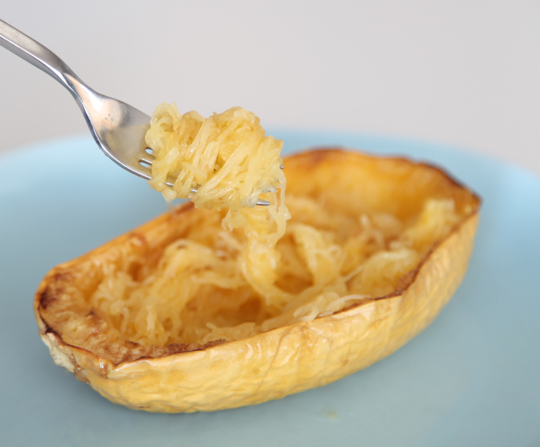
Want to add more cheese? Top the squash, marinara sauce and chicken with grated Parmigiano-Reggiano and mozzarella. Return to the oven (or put under the broiler) until the cheese is melted.





June 10, 2016
Thanks to Primal Living, at 49 I Look and Feel Better Than Ever
It’s Friday, everyone! And that means another Primal Blueprint Real Life Story from a Mark’s Daily Apple reader. If you have your own success story and would like to share it with me and the Mark’s Daily Apple community please contact me here. I’ll continue to publish these each Friday as long as they keep coming in. Thank you for reading!
 I’ve been thinking about submitting my success story for a while, but held back because it wasn’t super dramatic. I didn’t lose 100 pounds or reverse diabetes. But I am more confident, energetic and adventurous than ever as I approach my 50th birthday, and it all started with upgrading what I was putting into my body.
I’ve been thinking about submitting my success story for a while, but held back because it wasn’t super dramatic. I didn’t lose 100 pounds or reverse diabetes. But I am more confident, energetic and adventurous than ever as I approach my 50th birthday, and it all started with upgrading what I was putting into my body.
I’ve always been relatively healthy, and I give a lot of credit to my family. Despite growing up in the 1970’s, there was no Tang or Tab served at 110 Glynn Lane. My mom bought organic bread from a local bakery, and fresh produce from a co-op. Some of our meat was even grass-fed since my grandmother lived on a wonderful farm.
It was because of the farm, however, and the fact that some of the animals I knew by name ended up on my dinner plate, that I became a vegetarian at the age of 11 or 12. I read Diet for a Small Planet and learned to combine various carbs to get enough protein. I stayed away from most of the fake meats but ate plenty of pizza and ice cream.
I was never a naturally athletic kid and was totally intimidated by sports since my gym teacher made fun of me. But I was active so weight was never an issue.
I had a different issue, however, which was acne. It started in my early teens and just never quit. I was on every possible prescription med, up to an including Accutane not once, but three times. It would clear my skin up for awhile, but it was dry and peeling.
I also always had digestive issues, which was diagnosed as irritable bowel syndrome. Oh, and I had some blood sugar issues too. So I was basically eating carbs all the time, which I now realize was what triggered the digestive stuff.
Fast forward to my early 40’s…nothing really changed. Still slim and in pretty good shape, but still plagued by acne and digestive stuff. And still an ovo-lacto vegetarian, eating fish from time to time. I read one of Carol Alt’s books about raw food and was hooked. Almost overnight I became a mostly raw vegan.
I soaked seeds and nuts and drank green smoothies like crazy. I discovered coconut oil and lots of good stuff that I still use and love. I also ate tons of dried fruit. This raw thing had to be the answer for my skin…I was putting so much good stuff into my body.
Unfortunately, my skin got worse. Nothing like severe cystic acne in your 40’s. The digestive stuff worsened too…despite being now painfully thin, I was bloated and uncomfortable. Some mild, underlying anxiety became pretty extreme. I was a hot mess. It couldn’t be what I was eating, right?
It was an article by Dr. Mercola that finally got my attention. He said cutting grains, dairy, and sugar could clear my skin, as long as I got plenty of high-quality protein and non-starchy vegetables. I started by adding pastured eggs. I cut out all the dried fruit and soaked and sprouted grains. Eventually, I started adding some grass-fed beef and wild caught fish.
My skin improved literally overnight. I could feel the inflammation subsiding each day.
I’m not sure how I first found MDA…I was always following links to different health related websites. But once I found it, I was hooked. I loved Mark’s direct but entertaining approach, and I felt like I had found a real community, even though it took me years to post a message!
So what makes me a success story? Well, I changed my diet because I wanted to clear my skin, and nothing else had worked. But there were more and more successes along the way. One day I realized that my digestive issues were a thing of the past. And the anxiety…gone, as my brain was getting the high quality saturated fat that it needed. Because of my interest in health and nutrition, I enrolled in the health coaching program at IIN. And that opened my eyes to even more. I finally saw that it wasn’t just about eating the right food and exercising. There was so much more—spirituality, career, and relationships all affect our health.
As I feel better and better in my own body I keep growing and changing. The girl who was intimidated in gym class now loves trying new things like indoor rock climbing and stand-up paddle boarding. I’m the first one to join in on silly pool games or a mechanical bull competition.
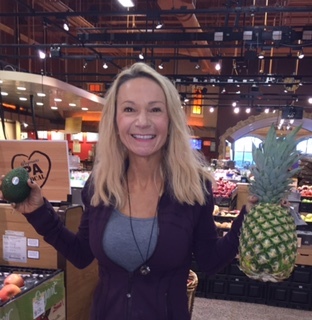 This new found confidence and fun-loving attitude led me to do something that I had been thinking about for years. I started a blog to share my love of healthy living in a fun, playful, and sometimes slightly inappropriate way. I love showing women how they can feel happy, healthy and hot by making some simple changes to what they put into, and on, their bodies. I talk about food, beverages, cosmetics and travel, along with goofy commentary about popular music and what I am wearing.
This new found confidence and fun-loving attitude led me to do something that I had been thinking about for years. I started a blog to share my love of healthy living in a fun, playful, and sometimes slightly inappropriate way. I love showing women how they can feel happy, healthy and hot by making some simple changes to what they put into, and on, their bodies. I talk about food, beverages, cosmetics and travel, along with goofy commentary about popular music and what I am wearing.
I am having a blast doing this, and love when I hear from women who are feeling better than ever after following my tips.
I want to say that there is nothing inherently wrong with being a vegetarian or vegan. It works for some, and it’s much better than following the standard American diet. But I can truly say that at 49 I look and feel better than ever in so many ways, and it all started with following a Primal lifestyle. Thank you to Mark and the entire MDA community for providing a wonderful forum that really brings people together.
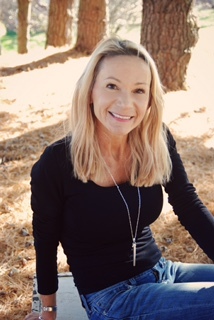 People often ask me what I eat. My days starts with a huge blended green drink, some of which I save for later, and coffee blended with coconut oil and collagen peptides. Later I’ll have pastured eggs over veggies if I’m home, or raw nuts and an apple if I’m out working on my blog. Lunch is a salad or leftover veggies with protein. Sardines are a favorite. Dinner is a small portion of high-quality protein and lots of veggies. If I want carbs I have sweet potato, but I usually don’t. Treats are dark chocolate pretty much every day and a glass of wine or two on the weekend. I love what I eat and feel great.
People often ask me what I eat. My days starts with a huge blended green drink, some of which I save for later, and coffee blended with coconut oil and collagen peptides. Later I’ll have pastured eggs over veggies if I’m home, or raw nuts and an apple if I’m out working on my blog. Lunch is a salad or leftover veggies with protein. Sardines are a favorite. Dinner is a small portion of high-quality protein and lots of veggies. If I want carbs I have sweet potato, but I usually don’t. Treats are dark chocolate pretty much every day and a glass of wine or two on the weekend. I love what I eat and feel great.
My story is not over. It is just beginning. Now that I have completed IIN, I would like to complete the Primal Health Coach program next. My blog is continuing to grow as more and more people jump on the happy, healthy and hot bandwagon. I plan to write some ebooks in the same fun, playful style, as well as offer some actual health coaching so I can work more closely with people. I also plan to write The Happy, Healthy and Hot Guide to Life, which will be published by Primal Life Publishing.
Thanks for reading!
Elizabeth







June 9, 2016
Introducing the Primal Health Coach Program (and Why I Consider It One of Our Most Important Endeavors)
 A couple years ago I had one of my biggest visions yet—something that felt bold, insistent, and personal. Approaching nearly a decade of putting my passion and resources into Mark’s Daily Apple, I knew the movement and community it had helped inspire were at a threshold point. I’d heard from so many readers over the years (many of them health practitioners) who were living according to the Primal Blueprint with incredible results but were increasingly frustrated by the lack of public attention and educational resources for this path to health. Some were even in the midst of medical training, receiving instruction on the worn, conventional teachings around nutrition, fitness, weight loss and chronic disease. These readers asked in their messages how they could reframe their education as well as medical practice to include the truths of the Primal Blueprint as they had experienced them first-hand. Could there be a means of direct Primal instruction to match that of conventional sources? Clearly, it was time to take Primal education to a new level, and that’s how the Primal Blueprint Certification was born.
A couple years ago I had one of my biggest visions yet—something that felt bold, insistent, and personal. Approaching nearly a decade of putting my passion and resources into Mark’s Daily Apple, I knew the movement and community it had helped inspire were at a threshold point. I’d heard from so many readers over the years (many of them health practitioners) who were living according to the Primal Blueprint with incredible results but were increasingly frustrated by the lack of public attention and educational resources for this path to health. Some were even in the midst of medical training, receiving instruction on the worn, conventional teachings around nutrition, fitness, weight loss and chronic disease. These readers asked in their messages how they could reframe their education as well as medical practice to include the truths of the Primal Blueprint as they had experienced them first-hand. Could there be a means of direct Primal instruction to match that of conventional sources? Clearly, it was time to take Primal education to a new level, and that’s how the Primal Blueprint Certification was born.
And, yet, even then the question has hung in the air: how do we best encourage the dissemination of the Blueprint model and support those who want to share it professionally as well as personally? What more could we do to open the way for people to effectively teach as well as advocate for the Primal promise?
The answer is this announcement today. I’m proud to introduce the first and preeminent ancestral health coaching school: the Primal Health Coach program.
In the last year since we started offering the Primal Blueprint Expert Certification, many of those who’ve completed the program have requested help in turning their new knowledge into a successful business. We listened.
In upgrading the certification to a full Health Coaching Program, we’ve partnered with Master Coach Christine Hassler to create new coaching instruction and business sales videos as well as an added Coaching Manual and other improvements to help you apply the advanced Primal Blueprint training to a new career in health coaching or to expand an existing professional role within the health and wellness or life coaching spheres.
We’ve designed the Primal Health Coaching coursework to include everything necessary to learn the full-scale science and practice of the Primal Blueprint model and to set up or enhance a related business. Participants will get the intensive, fully-drawn explanation of the PB’s metabolic logic, the advanced physiological principles of Primal fitness, the detailed science of sleep, an in-depth primer on epigenetic influences, and more wide-ranging information to use with coaching clients to upgrade their health to Primal vitality. Those who take the program will also benefit from the series of coaching videos and resources, which delve into the psychological dimension of coaching and offer take-home strategies they can apply in their sessions with clients. Finally, they’ll learn the basics of establishing and growing a thriving coaching business.
With the quickly expanding role of health coaching in the field of health care today and the explosion of obesity and chronic disease rates, there’s never been a better time to join this mission. That’s why my team and I have doubled down on this Primal vision by upgrading this comprehensive educational certification to include an expertly designed coaching training program. The best way, I truly believe, to help the most people is by training others to become effective coaches who can take the Primal Blueprint message to the millions in dire need of personal support and accurate information as they seek to reclaim their health.
As one of the first certified Primal Health Coaches, you’ll be given tools and skills to help you embark on a potential career you can feel personally invested in, align with the Primal Blueprint, and make a name for yourself in the ancestral health movement. You’ll have the opportunity to be part of the solution to the health problems and false paradigms that plague our society today. As a Primal Health Coach, you’ll have the chance to merge your passion with your profession in a business role you fully direct. As a side pursuit or a full-time career, you’ll be your own boss and conduct your business on your terms from home or within the professional community and setting of your choice.
And let me add that if you’ve always considered doing the Primal Certification for your own edification, to dig deeper into the science and application of the Blueprint for your own sake without professional aspirations, the program is absolutely still a great resource for you. The certification coursework has been enhanced in areas but remains fully intact. The central change has been the addition of new modules and videos about coaching. We welcome any and all who want to become experts in the Primal field.
Folks, I’ve never been more excited about the future of Primal living as I am today. I’m proud of what my team has accomplished and grateful for the members of this community, who have provided continual support and feedback that have guided us as we developed this program.
Whether or not you’re looking to take the course, I hope you’ll jump over to the new site and have a look around. Read the blog, which is growing as we speak, to learn more about what health coaching is, what makes Primal Health coaching unique, and why health coaching matters more than ever. They’ll be plenty more to come on the blog each week with practical coaching strategies, business planning tips, and coaching-friendly Primal guides. And if you think you may want to join the program or just want to learn more, subscribe and you’ll get access to a free half-hour informational video made by yours truly.
Of all our projects here at Primal Blueprint, Inc., the ones that excite me the most are those that catapult the message far beyond the scope of this blog to make a difference in countless people’s lives and health. I’m looking forward to watching the Primal Health Coach community grow and to sharing the stories that result from its impact.
Thanks for reading, everyone. Join us at Primal Health Coach, and let me know what you think. Have a great end to the week.




June 8, 2016
14 Ways to Help You Look Primal
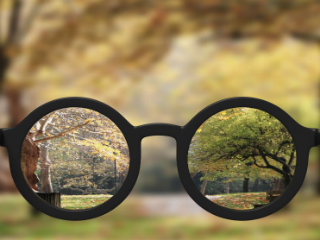 Do you look Primal?
Do you look Primal?
I don’t refer to chiseled abs, prominent shoulder striations, and bulging calves that draw queries from failed actors. I’m not talking about loincloths, or fur togas, or wild unkempt hair and scraggly beards, or any of the other aesthetic choices paleo-reenactors make. In fact, this isn’t about your appearance at all; it’s about how you’re using your eyes to look at the world.
I mean: are you using your eyes in an evolutionarily-congruent fashion? Do you look Primal?
First, let’s explore just how Grok would have used his eyes.
There was closeup looking:
Tool-making and manipulation.
Arts, crafts, and jewelry production.
Preparing the weapons of the hunt. Notching arrows, stringing bows, sharpening axes and blades.
Starting fires.
Discerning between edible and inedible plants.
There was far-off looking:
Gazing at the sunset or sunrise.
Observing herds and gauging their trajectory.
Spotting prey off in the distance.
From a ridge half a mile up regarding the valley below and a path through it to the other side.
Viewing layers of hills stacked against one another, getting bluer as they stretch toward the horizon.
Watching birds overhead.
Throughout it all, there was a lot of gaze shifting. There was no staring at a leaf for six unblinking hours straight. Tool production was protracted, but not a daily occurrence. Vision frequently shifted between both near and far objects and back again. The muscles controlling the eye moved—a lot. “Move frequently at a slow pace” applies to the entire body.
How about these days? What’s Ken Korg doing with his eyes?
There’s a lot of closeup looking:
We’re staring at a smartphone held 12 inches away.
We’re staring at a computer screen 15-24 inches away.
We’re looking at flat, linear surfaces. Our eyes don’t have to shift focus. We’re looking at the same flat object for extended periods of time. Even our ancestors doing close up work in the past worked with three dimensional objects, so their focus was slightly shifting all the time.
And we’re doing this for unbroken hours a day. We don’t even blink when looking at a screen. Compared to the 10-20 blinks per minute when looking at the rest of the world around us, when gazing into a screen we blink 2-4 times a minute. We can’t pull away. We can’t avert our gaze, not even for the millisecond it takes to lubricate and irrigate our eyes with a swipe of an eyelid.
There’s some midrange looking:
We might crane our necks to see the traffic situation past the next car.
We might squint at the sunset before dropping the sunshade so we can avoid crashing on our commute home.
We’ll look down the street of our subdivision to see if the garbage truck’s coming.
And as for far-off looking? Beyond the annual camping trip to some gorgeous national park with stunning vistas and occasional forays to the beach or desert or whichever wild locale lies within an hour’s drive, we rarely get the chance to look at objects far off in the distance.
We’re certainly not looking up at the stars. Hell, if we live anywhere near a city, we can’t even see the stars.
Why does this matter?
The eye isn’t a passive recipient of visual data. The cornea bends and curves accommodate the subject’s proximity.
Gazing at things up close tenses the ciliary, the eye muscle responsible for controlling the shape and curvature of the cornea and focus of the eye. It elongates the eye. Gazing at things off in the distance relaxes the ciliary. Looking at things close up is hard work; it’s like sprinting or lifting weights. Looking at things far away is easy; it’s like taking a leisurely walk. We need both. But, increasingly, we’re only doing the first. And it’s taking a toll.
Myopia is chronic elongation of the eyeball, which focuses the light from far-off objects just in front of the retina rather than directly on it. This inhibits the eye’s ability to focus on anything but what’s right in front of it. It’s like chronic contraction of any muscle. Eventually, stuff gets locked up. Eventually, positions become default. These days, myopia, or nearsightedness, is the most common eyesight disorder. An estimated 90% of Chinese teens and adults, half of all young adults in Europe and America, and a whopping 96% of 19 year-olds in Seoul, South Korea are nearsighted. Those are astounding numbers.
What can you do? How do you look Primal?
1. Look at something else
Screens fascinate us because they’re always changing, there’s always something new like an email, a Tweet, a hilarious GIF, or an incoming text. We never have to confront the existential dread simmering within if we don’t want to. The screen tempts our desire for novelty without ever really satisfying it. When you’re going through the motions, taking the same route you always take, eating the same meal you always eat, sitting down on the same side of the couch you always sit on, pulling out the phone is the simplest path to novelty. But it’s hell for our eyes, so you need other sources.
2. Forget your phone sometimes
I would say, “Don’t look at your phone so much,” but we’re addicted to the things. That doesn’t work when your physiology compels you to check it and your stress hormones rise because you haven’t looked at it in the last ten minutes. Remove it from the equation by removing it from your person. Go for a walk without burying your face in a screen, grab a coffee and finally start that book you bought three months ago, meet a friend for dinner and chat unencumbered by the nagging presence of your phone. It’s not that hard if you don’t have the thing in the first place.
3. Take your contacts out or remove your glasses sometimes
Long term use of contacts thins the cornea while increasing surface curvature and irregularities. This is a well known but underreported side effect of contact lenses. Akin to protective, restrictive shoes weakening the foot, contacts appear to act as a crutch. That’s not to say they’re not helpful or necessary. But it comes with a cost, like most modern medical interventions.
If you don’t need your contacts or glasses for whatever you’re doing, remove them. Certain situations call for them. But just hanging around? Lots of folks can see up close just fine without their contacts, but because they’re used to wearing them (and removing them is a hassle), they leave them in.
4. Consider lower prescription lenses
Try 0.5 less than you were prescribed. It’ll help your vision but cause less thinning than full prescription. And if commit to it, you may be able to titrate even lower as you get acclimated to the new prescription. Train your eyes.
Todd Becker describes the method in detail.
5. Eat your fish
Omega-3s offer a range of benefits for eye lubrication. They reduce dry eyes in contact wearers, heavy computer users, and rosacea patients.
6. Eat vitamin A
Turns out that carrots really are good for your vision. A 2005 study found that vitamin A from either goat liver, supplements, carrots, fortified rice, or amaranth leaves improves night vision in pregnant women (liver and supplements were most effective). Other studies have found similar results.
Pre-formed vitamin A might be better than vegetable carotenes. Vitamin A, or retinol was discovered after scientists found adding butter or egg yolks to carotenoid-deficient diets prevented blindness in animals. It’s only found in animal products like liver, egg yolks, cod liver oil (also a good source of omega-3s) and grass-fed dairy. Rather than rely on the human body’s often inefficient conversion of carotenoids into retinol, let animals do it for you.
7. Blink
When we’re focusing on something (making a tool, skinning an animal, skewering a Twitter opponent), we stop blinking. But blinking nourishes our eyes and keeps them lubricated. If you’re reading this, you’re probably a frequent user of technology who focuses their eyes and you should probably blink more often. This isn’t easy. You’re gonna have to remind yourself to perform a normally subconscious physiological task.
Setting up a “blink alarm” could work, but it’d have to go off every fifteen seconds and would certainly disrupt your work flow. You and a colleague could remind each other to blink, but that’d also be disruptive. Perhaps the simplest and least intrusive reminder is a piece of paper with “blink” written on it attached to your computer.
8. Take frequent vision breaks
Every 20 minutes or so stop what you’re doing and look at something far away. Some people say 20/20/20—every 20 minutes, spend 20 seconds looking at something 20 feet away. Either way works. This allows your eyes to unfocus and relax.
An alarm should work great here. Set it go off every 20 minutes until you get used to the idea. You might make it a walking break while you’re at it, because why not?
9. Wear glasses, not contacts
If you have to wear something for close-up work, choose glasses. Contacts dry the eyes and reduce lubrication/blinking. All this increases eye strain and heightens the unwanted adaptive response of the eye musculature.
10. Keep your screen (or book) at least an arm length’s away
Don’t hunch over your screen. Don’t press your mug against it. Keep it at least an arm’s length from you. Use larger font if you have to; it’s not the size of the font but the physical distance that changes how your eye muscles contract.
11. Take off the shades sometimes
Sunglasses are a fantastic invention. I wear them myself sometimes. But pure unfiltered sunlight itself appears to have beneficial effects on eye health in moderate doses. Don’t go blind. Don’t stare into the sun. However, just like you can expose your skin to sun without getting burnt, you can expose your eyes to sunlight without damaging them. And I strongly suspect you should. Even if it doesn’t improve adult eye health, getting natural sunlight into your retina during the day will improve your sleep and increase your resistance to the circadian-disrupting effects of nighttime blue light.
12. Go outside
The relationship between outdoor time and vision problems is unclear. Whether going outdoors actively improves eyesight, or it improves eyesight because time outdoors is time spent not staring at a screen doesn’t really matter. The fact is when you go outside you’re looking at objects all over the place, both near and far away. You’re getting sunlight into your eyes. You’re getting vitamin D, which could be a proxy for outdoor time and light exposure but is linked to better eyesight. You’re relaxing your eye muscles and practicing “general vision” rather than focusing on a single two dimensional plane 12 inches in front of your face. It’s all good.
13. Look “through” objects
Hold your fist up about a foot from your face and look directly at it. It will obscure whatever lies behind it. Now look “through” it. You’ll suddenly be able to see whatever’s behind your fist. Your fist will appear as a small sliver in the middle of your vision and your eyes will be incredibly soft and relaxed. If you can’t figure this one out, try hidden image stereograms. Hidden image stereograms are tiled patterns that reveal hidden images when you look “through” the stereogram. I remember doing these in grade school. Check out the parallel view, cross view, and magic eye subreddits for some resources.
14. Look at really far-off objects
Anything works. Vistas. Sunsets. Mountains. Climbing a mountain above your city and trying to spot your home. Horizons. Tracking a jet flying overhead.
This post won’t cure blindness, or myopia, or allow you to switch prescriptions. But it may help improve your situation a bit, and it definitely won’t hurt your eyesight or accelerate its degeneration.
Thanks for reading, everyone. Got any more tips? Stories? What’s worked and what hasn’t for your vision?
Prefer listening to reading? Get an audio recording of this blog post, and subscribe to the Primal Blueprint Podcast on iTunes for instant access to all past, present and future episodes here.




June 7, 2016
Why the Kind of Body Fat You Carry Matters
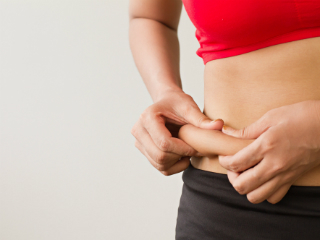 All fats are not created equal. We know this because we’re constantly correcting people who get it wrong. There are good fats and bad fats and really really bad fats and fats that are conditionally good or bad. Butter isn’t corn oil isn’t fish oil isn’t monounsaturated fat isn’t palmitoleic fat isn’t linoleic acid. Sometimes trans fat isn’t even trans fat. The same thing applies to the fat on your body. Depending on its location and composition, healthfulness isn’t distributed equally among adipose tissue. Some types of body fat are worse than others.
All fats are not created equal. We know this because we’re constantly correcting people who get it wrong. There are good fats and bad fats and really really bad fats and fats that are conditionally good or bad. Butter isn’t corn oil isn’t fish oil isn’t monounsaturated fat isn’t palmitoleic fat isn’t linoleic acid. Sometimes trans fat isn’t even trans fat. The same thing applies to the fat on your body. Depending on its location and composition, healthfulness isn’t distributed equally among adipose tissue. Some types of body fat are worse than others.
Fat is an endocrine organ. Like any other organ, it secretes hormones and other bioactive compounds that affect our physiology and determine our health.
Subcutaneous fat sits just below your skin. It’s the most conspicuous and least aesthetically-pleasing fat, comprising love handles and big droopy bellies, saggy arms and flabby necks, but it’s less actively harmful than many other types of body fat. Subcutaneous fat is the primary secretor of leptin, a strong regulator of appetite and metabolism, and of adiponectin, a marker for metabolic health with potentially anti-atherosclerotic effects.
Gluteofemoral fat is lower body fat, specifically the stuff that sits on your butt, hips, and thighs. In women, its presence indicates (and may even determine) good metabolic health. And it may not just be a signal for health, but an actor. Fat depots on the butt and hips actively secrete greater amounts of palmitoleic acid (PDF), a fatty acid with insulin-sensitizing effects. Gluteofemoral fat contains a greater proportion of omega-3 fatty acids, which are used to construct baby brains.
Visceral fat lies inside the abdominal cavity. It surrounds and envelops the organs. Contrasted with subcutaneous fat, visceral fat releases far less leptin and adiponectin. Instead, it secretes large amounts of IL-6, an inflammatory cytokine strongly correlated with systemic inflammation.
Intrahepatic fat is fat inside the liver. More than any other type of fat, intrahepatic fat is strongly associated with the metabolic complications of obesity.
Epicardial fat is visceral fat that surrounds the heart. If you’ve ever gotten a cow heart wrapped in hard yellowish fat, that’s epicardial fat. Large amounts of epicardial fat are associated with obesity, diabetes, and hypertension. And while epicardial fat appears to be primarily a signal of metabolic disturbances, it also exerts direct effects on heart function and releases inflammatory molecules that affect surrounding tissues.
Intermuscular fat lies between muscles. The less you use a muscle, the more it atrophies and the more fat will replace it. You may have seen the MRI of two thigh cross sections—one from a lifelong athlete and one from an age-matched couch potato. The athlete’s leg is a dense circle of bone surrounded by several inches of lean muscle in each direction followed by a small layer of fat. The sedentary leg is smaller circle of bone surrounded by a mishmash of marbled meat with several inches of thick white fat. Delicious and tender when seared, I’d imagine, but terrible for the person’s health and ability to function.
Intramuscular fat lies inside the muscles. Kobe beef steaks have lots of intramuscular fat. It’s the marbling, the presence of fat between muscle fibers. If you actually utilize it, intramuscular fat provides a nice source of energy for the muscles. Then again, if you were using your muscles in the first place it’d be tough to accumulate much intramuscular fat. The quickest way to get rid of intramuscular fat is with low-level aerobic activity. Staying under 75% of max heart rate will keep you burning predominately fat, and exercising while on a ketogenic diet is an even better way to do it; nutritional ketosis increases exercise-induced intramuscular fat oxidation 20-fold.
Brown fat isn’t really fat. It is, but it isn’t. Like muscle, it’s highly metabolically active. We use it to generate heat (thus burning energy) in response to cold exposure. Babies have a ton of brown fat, since they can’t shiver to stay warm, and until recently researchers assumed adults didn’t have much at all. Now we know that’s wrong. Cold plunges, swimming in cool water, and even going outside in short sleeves and shorts in cold weather can all stimulate the formation of brown fat in adults (I wouldn’t advise dunking your newborn in an ice bath for the health benefits). Those jerk babies aren’t the only ones enjoying that sweet, sweet brown fat after all.
Best of all, “training” for brown fat—in one study, exposing yourself to cool weather (60°F) for just 2 hours a day for six weeks while wearing light clothing—can increase energy expenditure and reduce overall body fatness. That’s not even a big dose of cold. Forgetting your jacket at home is probably enough.
Different populations have different body fat distribution patterns. Let’s look at a few:
South Asians (Indians, Pakistanis, Bangladeshis) have smaller subcutaneous “reservoirs” than whites, so a larger proportion of weight gain in this population diverts to visceral—and more dangerous—fat stores. Dr. Ron Sinha wrote about this (and still does on his blog) in the fantastic South Asian Health Solution.
Compared to Australian whites, Japanese men have more body fat for a given BMI.
Black Americans have less visceral fat and more subcutaneous fat for a given BMI than white Americans (PDF). Oddly, this doesn’t translate to a lower risk of diabetes.
Australian Aborigines have more trunk fat and less limb fat for a given BMI than Australians of European descent. Aborigine women have higher waist circumferences and waist:hip ratios than Aussie European women for a given BMI.
Men and women carry fat differently. I mentioned that briefly above in the section on gluteofemoral fat, and I covered the differences extensively in a previous post. Go read that now. In short, men are more likely to store fat on the trunk and around the waist, leading to the fat-guy-with-stick-legs syndrome. Women tend to store fat in the butt, thighs, and hips. Upon reaching menopause, women stop producing as much estrogen and begin storing more fat in the waist and abdomen.
The eternal question persists: is it cause or signal? Risk factor or actor? For most of these types of fat, the answer is probably “both.” Fatty liver indicates metabolic dysfunction, but it can also impair the liver’s functions and lead to insulin resistance and eventually diabetes. People with lots of brown fat may be lean and healthy because they spend a lot of time being active in cold weather, but the brown fat also increases caloric expenditure. Large amounts of intramuscular and epicardial fat indicate a sedentary lifestyle, which is damaging in its own right, but the fat secretes inflammatory compounds with real biological effects.
Teasing apart which link along the chain of causality is to blame is probably impossible. That doesn’t mean we can’t make a few safe recommendations.
Women shouldn’t stress out about a little butt, hip, and thigh fat. It’s likely a good sign.
Belly fat is bad. Fat around your heart is bad. Fat in your liver is bad. Subcutaneous fat looks bad and is hardest to burn but might not be too unhealthy. Losing weight will reduce all of it.
To target belly fat, intense training works best. The resultant spike in catecholamines will preferentially target visceral fat. Just be sure to get enough sleep, rest, and recovery, as chronic stress and under-recovery tends to chronically elevate the catecholamines and make belly fat more stubborn.
To target liver fat, limit sugar, eat lots of choline (from yolks and liver), and practice high intensity interval training. When you drink alcohol, make sure you protect your liver with saturated fat (beef, cocoa, coconut fat all protect against alcohol-induced fatty liver).
To target intramuscular fat, exercise in a low-carb or ketogenic state. Nothing too intense is required. A long, reasonably intense hike (lots of hills) on an empty stomach twice a week might do the trick.
To target epicardial fat, exercise. Both intense and moderate-intensity training seem to work.
To get more brown fat, forget your jacket. Heck, burn it. Just don’t stand too close to the fire.
If it sounds confusing, it shouldn’t. The basics apply. Recommendations haven’t changed. I just find all the different types of fat incredibly interesting. Don’t you?
Thanks for reading, everyone. Take care and be sure to let me know what you think about all this.




June 6, 2016
Dear Mark: Dried Sardines, Pullup Alternatives, and Blood Donation for Women
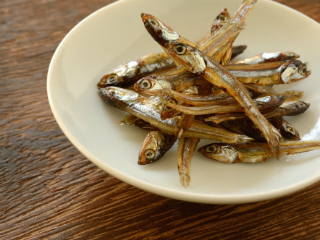 For today’s edition of Dear Mark, I’m answering three questions from readers. First concerns an alternative form of a food I’ve always urged people to consume: small dried whole fish. Are the omega-3s still viable after the drying process? Next, pullups are a fantastic exercise that everyone with the ability should perform, but not everyone has access to a pullup bar. What other exercises can you do to approximate, if not altogether replace, the humble pullup? And finally, in previous posts I’ve mentioned the potential health benefits of regular blood donation for men. Does the same apply to women? After all, they already “donate” blood on a regular basis through menstruation. What about post-menopausal women?
For today’s edition of Dear Mark, I’m answering three questions from readers. First concerns an alternative form of a food I’ve always urged people to consume: small dried whole fish. Are the omega-3s still viable after the drying process? Next, pullups are a fantastic exercise that everyone with the ability should perform, but not everyone has access to a pullup bar. What other exercises can you do to approximate, if not altogether replace, the humble pullup? And finally, in previous posts I’ve mentioned the potential health benefits of regular blood donation for men. Does the same apply to women? After all, they already “donate” blood on a regular basis through menstruation. What about post-menopausal women?
Let’s go:
Hello Mr. Sisson,
I live in Japan and have ample access to a wide variety of fish. The problem is that a lot of it is farm-raised, and I want to stick with smaller fish that have fewer heavy metals in them. I can find a lot of dried smaller fish, like infant sardines, with no added ingredients. Just boiled in salt water and dried. And I like eating the whole fish because of the calcium and other nutrients from the bones. My question is — do these dried fish provide any of the beneficial Omega 3 fatty acids that their fresh counterparts do? Thank you.
There’s probably going to be some degradation of the fats, as happens with any form of processing, whether it’s cooking, canning, smoking, even freezing. Let’s look at what happens to the omega-3s in dried, smoked salmon—one of the more studied fish. This should give us a decent idea of how the omega-3s in small dried fish should respond.
A 2009 study found that smoking salmon at 95 degrees Celsius made the fish fats even more oxidatively stable than fresh salmon, with a lower peroxide value, fewer TBARS, and fewer free fatty acids.
Separating a food into its constituent parts increases each part’s susceptibility to degradation. Olive oil is less stable than whole olives, for example. That your dried fish are whole is a huge positive. The omega-3s in whole dried fish are protected by “nature’s packaging.” The salmon from above were filets rather than whole fish, and their omega-3s still remained whole. I’m confident the omega-3s in your dried sardines will be just fine.
But small dried fish without added ingredients are an incredible source of other nutrients, not just the omega-3s. Take whole dried smelt, another small fatty fish low on the food chain. They’re full of vitamin B12, iron, magnesium, protein, calcium, and selenium. It’s a great thing to eat, and sardines should be very similar.
Whenever you can eat the whole animal, do it. You’re not just eating this piece of tissue or that organ or this cross section of muscle. You’re eating the entire thing. However small it is, eating an entire animal provides a wider range of nutrients. Always say yes to the whole animal, whether it’s a freezer full of dismembered cow or an oyster.
I don’t have a pull-up/chin-up bar. Is there anything else I can do to substitute this area of your exercises?
Oh, yes.
Grab a set of gymnastics rings. You can string them up over anything that will hold your weight. Support beam running across your ceiling that’s too high to grab for pullups but reachable with a ladder? Throw the rings up and do pullups on those.
Do bodyweight rows underneath a table. Pullups are incredible, but the real key is pulling. You don’t have to do vertical pulling. Horizontal pulls are just as useful. And I bet you have a table. Just make sure it’s sturdy enough to support your pulling. Put your legs up on a chair to increase the difficulty; keep them on the ground to make it easier.
Fingertip pullups. If you can find a couple inches of ledge overhead, you can do pullups. It won’t be easy. You won’t be able to do as many as you can on a bar. But your fingers will get strong right alongside your lats, biceps, and torso. After a few months of fingertip pullups, standard-issue pullups will be a breeze.
Inverted hand plank. Some folks call this the bicep plank. It’s exactly what it sounds like: get in the plank position with hands flat on the floor, only turn them so that your fingers are pointing toward your feet and the inside of your wrists face in front of you.
Band pulls. Attach the band to a sturdy support about waist height. Bend over at the hips until your torso is parallel to the ground. Clutch the band overhead and pull toward your body. Sort of a sideways pullup.
None of these will totally replace the pullup, though. Do your best to get your hands on a horizontal overhead bar.
Mark! Hi there. I’ll get right to it. I have read that giving blood a couple of times per year is good for the body for a number of reasons. Do you agree? Can you expound on this? Is it the same for women and men since we bleed every month and you guys don’t? Thanks in advance for sharing your wisdom and experience!
Lauren C.
Before menopause, you don’t need to give blood for health reasons. Men have no real way to shed excess iron, but menstruating women do. You can still donate blood for humanitarian reasons, of course. Just make sure to get regular tests to monitor your iron levels. Anemia is a real thing, and studies indicate that women experience more adverse reactions to blood donation than men.
Once menopause rolls around, all bets are off. You’re no longer shedding iron each month. Like men, you’re accumulating it. Some researchers have proposed. The drop in estrogen gets the most attention and blame for menopause symptoms, but estrogen has a concurrent and inverse relationship to iron in post-menopausal women. As estrogen declines, iron goes up. Is this a problem? Probably:
Menopause increases the storage of iron in skin, likely accelerating its aging and wrinkling, and perhaps responsible for the increased incidence of dermatosis.
Elevated iron levels may increase the risk of atherosclerosis and metabolic syndrome in post-menopausal women, but not in pre-menopausal women.
Excess iron accelerates bone loss in middle-aged men and post-menopausal women.
I was unable to find any trials testing the health effects of blood donation in post-menopausal women, but it’s quite beneficial for men. Might be worth a shot if your iron levels are elevated.
That’s it for today, folks. Thanks for reading!




June 5, 2016
Weekend Link Love – Edition 403
 Heads up. For the month of June, the following digital books are on sale for only $3.99 on Amazon: Primal Blueprint Healthy Sauces, Dressings and Toppings, Primal Blueprint Quick and Easy Meals, Paleo Primer, Rich Food, Poor Food, and Primal Cravings.
Heads up. For the month of June, the following digital books are on sale for only $3.99 on Amazon: Primal Blueprint Healthy Sauces, Dressings and Toppings, Primal Blueprint Quick and Easy Meals, Paleo Primer, Rich Food, Poor Food, and Primal Cravings.
Watch me talk about longevity at this free online anti-aging summit.
Research of the Week
Studies like this one are why I make Primal Master Formula and Primal Damage Control.
In orcas, culture drives genetic change.
25% of calories from added sugar is totally fine, guys. A guy without any conflicts of interest says so.
The unexpected benefits of chelation therapy in heart disease.
A paleo diet works even better with exercise.
Using blue-blocking glasses at night enhances bipolar disorder treatment.
New Primal Blueprint Podcasts

Episode 122: Richard Veech: Host Elle Russ chats with Dr. Richard Veech, the NIH scientist, research biochemist, and MD who figured out how to bottle ketones into an FDA-approved supplement. If you’re at all interested in the science behind ketosis, today’s episode is right up your alley.
Each week, select Mark’s Daily Apple blog posts are prepared as Primal Blueprint Podcasts. Need to catch up on reading, but don’t have the time? Prefer to listen to articles while on the go? Check out the new blog post podcasts below, and subscribe to the Primal Blueprint Podcast here so you never miss an episode.
The Health Paradox Paradox
Humility: A Primal Virtue with Modern Value
8 Essential Tips for Primal Men
Interesting Blog Posts
We got some really cool traits from our romantic dalliances with Neanderthals and other archaic human, but also some bad ones.
Beautiful (but unfortunate) graphical representation of the changing American diet. Note the declines of beef and whole milk, the ascent of cooking oil and low-fat dairy, and weep.
Media, Schmedia
In Tampa Bay (and likely elsewhere), “farm-to-table” doesn’t mean much.
Pediatric hospitals are realizing the importance of sleep for their in-patients’ recovery, but the proposed solutions aren’t very impressive. White noise machines won’t cut it. They need to do something about all the lights.
Everything Else
The strange story of the Afghan tamale vendor living on the Wyoming frontier at the turn of the 19th century who slaughtered his own animals halal-style, served Indians when many businesses wouldn’t, evaded public censure because his food was too good, and eventually paved the way for today’s small but persistent Wyoming Muslim community.
I can’t improve it, so I’m just going with the headline: “Sausage-Wielding Gang Attacks Vegan Cafe.”
This is why we paddle.
This is just crazy.
. You can stop reading after the headline, though.
Watch out how you clean your grills.
Recipe Corner
This baked chicken tomato kale curry is simple, delicious, and nutrient-dense.
Good watermelon has arrived. Time to make watermelon tomato salad with cilantro and jalapeño.
Time Capsule
One year ago (June 8 – June 14)
5 Reasons to Run Outside Instead of on a Treadmill – It’s just not the same.
The Power of Your Food Dollars – How the contents of our shopping cart can change the world.
Comment of the Week
Japanese eat very little fat and suffer fewer heart attacks than us.
Mexicans eat a lot of fat and suffer fewer heart attacks than us.
Chinese drink very little red wine and suffer fewer heart attacks than us.
Italians drink excessive amounts of red wine and suffer fewer heart attacks than us.
Germans drink beer and eat lots of sausages and fats and suffer fewer heart attacks than us.
The French eat foie-gras, full fat cheese and drink red wine and suffer fewer heart attacks than us.
CONCLUSION: Eat and drink what you like. Speaking English is apparently what kills you.
Copy and Paste from drmalcolmkendrick.org
– Well said, Solomon. I always like Dr. Kendrick’s stuff.




June 4, 2016
Primal Korean Bibimbap
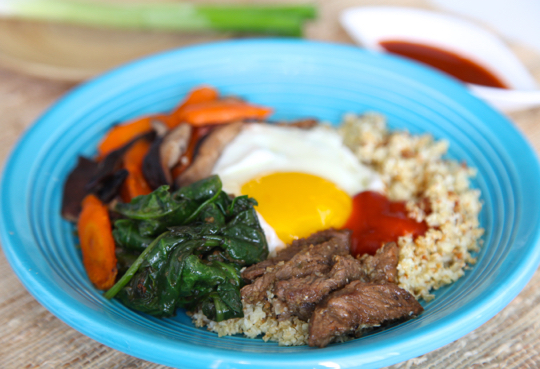 Bibimbap, a dish made up of white rice mixed with vegetables, meat, egg and a fermented condiment or two, is Korean comfort food. A quick Primal change (switching out white rice for cauliflower rice and modifying the beef marinade) turns Bibimbap into comfort food that’s also quite healthy.
Bibimbap, a dish made up of white rice mixed with vegetables, meat, egg and a fermented condiment or two, is Korean comfort food. A quick Primal change (switching out white rice for cauliflower rice and modifying the beef marinade) turns Bibimbap into comfort food that’s also quite healthy.
The crowning glory of this flavorful one bowl meal is gochujang, a fermented paste made of chili peppers, soybeans, rice, and salt. The flavor is salty, slightly sweet and spicy. If you like your food spicy, there are infinite ways to use gochujang. Serve it with meat and vegetables, scrambled eggs, or stirred into soup and stews.
Usually, the ingredients for Bibimbap are cooked in quick succession in the same skillet. In this lazier version, the cauliflower rice, carrots and mushrooms are roasted in the oven while the meat marinates. The meat and spinach are quickly sautéed, then everything is thrown together for a meal overflowing with salty, sweet, and spicy umami flavors.
Servings: 4
Time in the Kitchen: 1 hour 15 minutes, plus 2 hours to marinate
Ingredients:
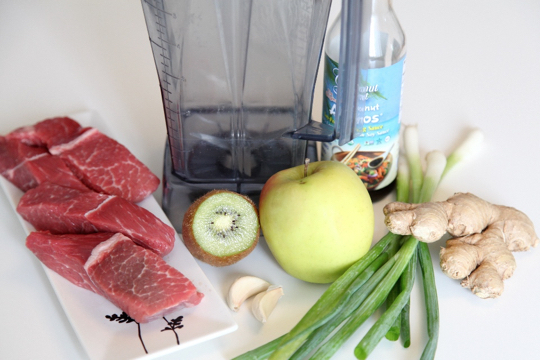
1 pound thinly sliced (1/8-inch) boneless beef rib-eye steak, boneless short ribs or hangar steak (453 g)
1 kiwi, peeled and chopped
1/2 Asian pear, or ½ apple, chopped
2 scallions, chopped
3 garlic cloves
1-inch/25 mm piece peeled ginger, finely chopped
1/3 cup coconut aminos (80 ml)
2 tablespoons unseasoned rice vinegar (30 ml)
4 carrots, peeled and cut on the diagonal into 1/4-inch/6 mm wide slices
10 ounces Shitake mushrooms, thinly sliced (284 g)
10 ounces baby spinach (284 g)
3 tablespoons plus 1/4 cup extra virgin olive oil or avocado oil (divided) (45 ml, 60 ml)
1 large head cauliflower, cut into small florets
4 eggs
Korean Gochujang Sauce
Instructions:
Cooking Tip: The easiest way to slice meat very thinly is to first wrap the meat in plastic wrap and put it in the freezer for 1 to 1 ½ hours so the meat becomes firm but not frozen.
In a blender or food processor, combine kiwi, pear/apple, scallions, garlic, ginger, coconut aminos and vinegar until smooth.
Cover the meat with the marinade. Chill 1 to 2 hours–no longer, or the meat will get mushy. Take the meat out of the refrigerator and let it come up to room temperature while you prep the veggies.
Heat oven to 400 °F/204 °C.
In a large bowl, toss mushrooms and carrots in 3 tablespoons oil. Lightly salt and pepper. Spread out on a large rimmed baking sheet.
Put the cauliflower florets in a food processor and process until the cauliflower is broken up into tiny pieces the size of rice. In a large bowl, toss the cauliflower with ¼ cup oil. Season lightly with salt. Spread the cauliflower out evenly in a thin layer on a large rimmed baking sheet.
Roast the carrots, mushrooms and cauliflower for 20 minutes, then stir each pan. Roast 10 minutes more, until the carrots and mushrooms are soft and the cauliflower is nicely browned. (The cauliflower rice can be left in even longer, for a crunchier texture.)
When the vegetables come out of the oven, heat a drizzle of oil (avocado oil works well) in a large skillet. Shake the marinade off the meat and cook the meat in three batches, so the skillet isn’t too crowded. Add more oil to the skillet between batches as needed. Cook each batch of meat 2 to 3 minutes, then remove from the pan and set aside.
When the meat is done, drizzle a little more oil in the pan and add the spinach. Saute in the oil and meat juices left in the skillet just until the spinach is wilted.
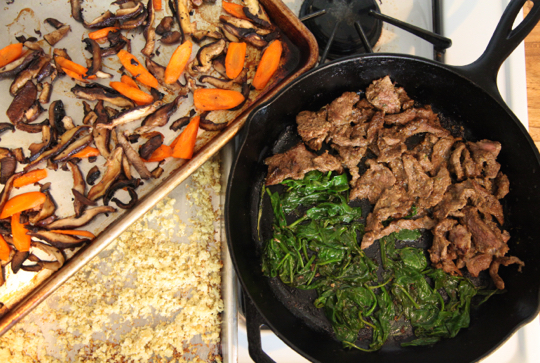
Divide the cauliflower rice between 4 servings bowls. Top with the carrots, mushrooms, spinach and meat.
Fry an egg for each bowl. Top each bowl with a fried egg and gochujang sauce.
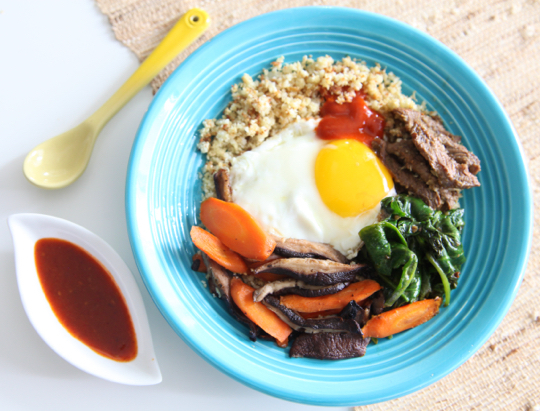
Like This Blog Post? Subscribe to the Mark's Daily Apple Newsletter and Get 10 eBooks and More Delivered to Your Inbox for FREE



Mark Sisson's Blog
- Mark Sisson's profile
- 199 followers



